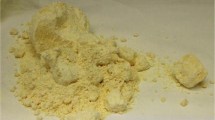Abstract
Based on the study performed, a conclusion was drawn that a system of procedures should be introduced into the practice of arbitration laboratories in order to identify the authenticity of cognacs and cognac spirits. These procedures were exemplified in the identification of diethyl phthalate in cognacs. Factors responsible for the falsely positive detection of diethyl phthalate in cognacs and cognac spirits were revealed. A substance that has a retention time equal to that of diethyl phthalate was identified as monoethyl succinate. As an example, recommendations were given for revealing adulterated cognac samples upon the detection of phthalic acid esters in them (including diethyl phthalate, which is a marker of denaturation). Sources of the contamination of test samples with diethyl phthalate were identified; an algorithm was developed for distinguishing between diethyl phthalate as an impurity component and diethyl phthalate added to an alcohol as a denaturation marker.
Similar content being viewed by others
References
GOST (State Standard) R 51 786-2001: Vodka and Ethyl Alcohol from Food Raw Material: Gas-Chromatographic Method for the Determination of Authenticity, 2001.
Avtomaticheskaya raspredelennaya informatsionnopoiskovaya sistema (ARIPS) “Opasnye veshchestva” (Automated Distributed Information-Retrieval System “Hazardous Compounds”), Reg. no. VT 000123 (Ethylene Glycol).
Avtomaticheskaya raspredelennaya informatsionnopoiskovaya sistema (ARIPS) “Opasnye veshchestva” (Automated Distributed Information-Retrieval System “Hazardous Compounds”), Reg. nos. VT 001674 (Diethyl Phthalate), VT 000108 (Acetaldehyde), VT 001181 (Diethyl Ether), and VT 000874 (Crotonaldehyde).
Documentation of the Threshold Limit Values and Biological Exposure Indices, Cincinnati: Am. Conf. Gov. Ind. Hyg., 2002, 5th ed.
Diethyl Phthalate: BUA Report 104, German Chem. Soc., 1994.
Gadalina, I.D., Ryazanova, R.A., Malysheva, M.V., and Pavlenko, S.M., Gig. Sanit., 1986, no. 7, p. 32.
Livanov, G.A., Bonitenko, E.Yu., Kalmanson, M.L., and Guchko, V.M., Zloupotreblenie alkogolem v Rossii i zdorov’e naseleniya. Ostrye otravleniya etilovym alkogolem i ego surrogatami. Somaticheskaya patologiya pri khronicheskoi alkogol’noi intoksikatsii (Alcohol Abuse in Russia and Population Health: Acute Intoxications with Ethanol and Its Surrogates. Somatic Pathology at Chronic Alcoholic Intoxication), Moscow, 2000, p. 62.
Luzhnikov, E.A. and Kostomarova, L.G., Ostrye otravleniya: Rukovodstvo dlya vrachei (Acute Intoxication: A Handbook for Physicians), Moscow, 1989.
Miroshnichenko, L.D. and Pelipas, V.E., Narkologicheskii slovar’ (Narcological Glossary), Moscow, 2001, vol. 1.
Nuzhnyi, V.P., Savchuk, S.A., Demeshina, I.V., et al., Novosti Nauki Tekhn., Ser.: Med., Moscow, 1999, no. 6, p. 1.
Nuzhnyi, V.P., Savchuk, S.A., and Kayumov, R.I., Narkologiya, 2002, no. 5, p. 43.
Postanovlenie EES (European Economic Community Resolution), no. 3199/93 of November 23, 1993.
Popravki k postanovleniyu EES (Amendments to the European Economic Community Resolution), no. 254/95 of October 31, 1995.
Savchuk, S.A., Brodskii, E.S., and Formanovskii, A.A., Zh. Anal. Khim., 1999, vol. 54, no. 8, p. 836 [J. Anal. Chem. (Engl. Transl.), vol. 54, no. 8, p. 741].
Savchuk, S.A., Vlasov, S.A., and Apollonova, S.A., Zh. Anal. Khim., 2001, vol. 56, no. 3, p. 246 [J. Anal. Chem. (Engl. Transl.), vol. 56, no. 3, p. 214].
Rumyantseva, L.A., Istomin, A.V., Khamidullin, R.F., and Timokhin, D.Yu., Gig. Sanit., 1999, no. 1, p. 46.
Bensafi, M., Rouby, C., Farget, V., et al., Neuroscience Lett., 2002, vol. 328, no. 3, p. 309.
GOST (State Standard) R 51 698-2000: Vodka and Ethyl Alcohol: Rapid Gas-Chromatographic Method for the Determination of Toxic Trace Impurities, 2000.
GOST (State Standard) R 51 355-99: Vodkas and Special Vodkas: General Specifications, 1999.
Nuzhnyi, V.P., Savchuk, S.A., Tyurin, I.A., and Belov, S.K., Toksikol. Vestnik, 2004, no. 3, p. 7.
Savchuk, S.A. and Kolesov, G.M., Zh. Anal. Khim., 2005, vol. 60, no. 8, p. 848 [J. Anal. Chem. (Engl. Transl.), vol. 60, no. 8, p. 752].
Author information
Authors and Affiliations
Additional information
Original Russian Text © S.A. Savchuk, G.M. Kolesov, 2007, published in Zhurnal Analiticheskoi Khimii, 2007, Vol. 62, No. 8, pp. 845–857.
Rights and permissions
About this article
Cite this article
Savchuk, S.A., Kolesov, G.M. Chromatographic determination of phthalic acid esters as an indicator of adulterated cognacs and cognac spirits. J Anal Chem 62, 761–772 (2007). https://doi.org/10.1134/S1061934807080126
Received:
Accepted:
Issue Date:
DOI: https://doi.org/10.1134/S1061934807080126




